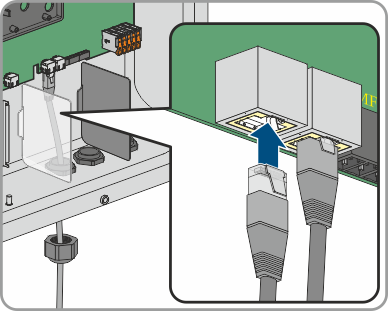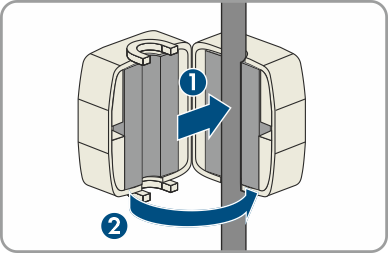Connecting the Network Cables
 Qualified person
Qualified person
 DANGER
DANGER
Danger to life due to electric shock in case of overvoltages and if surge protection is missing
Overvoltages (e.g., in the event of a flash of lightning) can be further conducted into the building and to other connected devices in the same network via the network cables or other data cables if there is no surge protection. Touching live parts and cables results in death or lethal injuries due to electric shock.
- Ensure that all devices in the same network are integrated in the existing overvoltage protection.
- When laying the network cable outdoors, ensure that there is suitable surge protection at the network cable transition from the product outdoors to the network inside the building.
- The Ethernet interface of the product is classified as "TNV-1" and offers protection against overvoltages of up to 1.5 kV.
Additionally required material (not included in the scope of delivery):
Network cables( > Network cable requirements)
Where required: Field-assembly RJ45 connector.
Procedure:
- Disconnect the inverter from all voltage sources ( > Disconnecting the Inverter from Voltage Sources).
- Unscrew the swivel nut from the cable gland.
- Thread a swivel nut over each network cable.
- Remove the four-hole cable support sleeve from the cable gland.
- For each network cable, remove one of the plugs from the enclosure openings and cut into each enclosure opening with a utility knife.
- Insert each network cable into one of the enclosure opening.
- Press the 4-hole cable support sleeve into the cable gland and guide each network cable to the network port.
- When using a self-assembly network cable, assemble the RJ45 connectors and connect them to each network cable (see connector documentation).
- Insert each network cable into one of the network ports.
- Ensure that the network cables are securely in place by pulling slightly on them.
- Place a ferrite around each network cable.
- Tighten the swivel nut on the cable gland hand-tight. This will secure the network cables in place.
- If the inverter is installed outdoors, install overvoltage protection for all components in the network.
- If you would like to integrate the inverter into a local network, connect the other end of a network cable to the local network (e.g., via a router).
- If you want to connect the inverter to an energy meter, connect the other end of the second network cable to the energy meter.


Also see:
